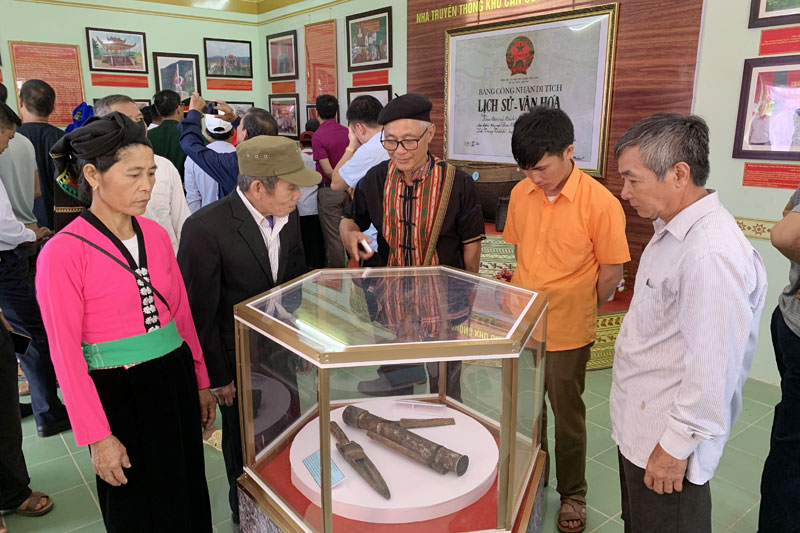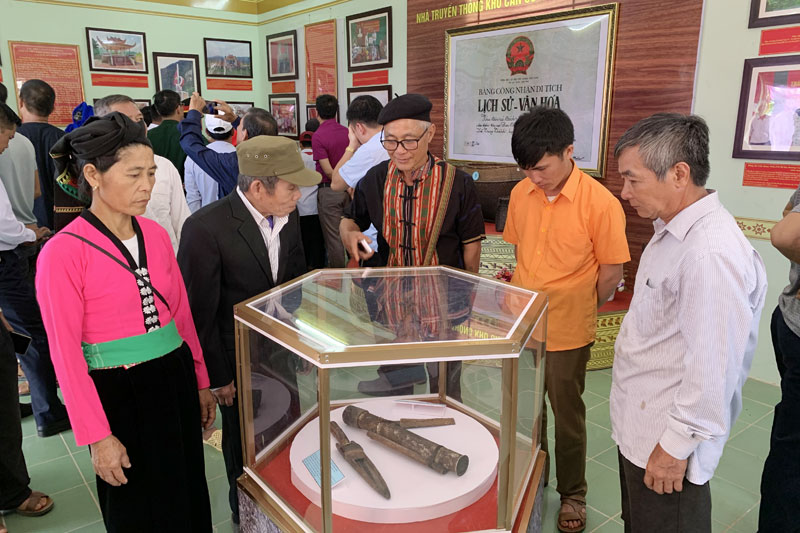
(HBO) - The provincial museum has the functions of researching, collecting, preserving and displaying the cultural heritage of ethnic groups in Hoa Binh province.
It is
also tasked with protecting, managing, restoring and promoting the value of
historical and scenic sites in the locality.
 Residents
in Trung Thanh commune visit the showroom on the Muong Diem
revolutionary base in Trung Thanh commune (Da Bac district).
Residents
in Trung Thanh commune visit the showroom on the Muong Diem
revolutionary base in Trung Thanh commune (Da Bac district).
In the first six months of 2020, the
provincial museum hosted successfully two exhibitions to celebrate the
locality’s major holidays and political events, one on the theme "Tu hao
90 nam truyen thong ve vang cua Dang Cong San Viet Nam” (The 90-year glorious
tradition of the Communist Party of Vietnam) and the other on "Chu tich Ho
Chi Minh – Lanh tu thien tai của Dang va Nhan dan ta” (President Ho Chi Minh - The
genius leader of Vietnamese Party and people).
It
also opened a showroom on the Muong Diem revolutionary base in Trung Thanh
commune (Da Bac district).
The provincial museum completed records of 41 relics and artifacts handed
over and donated by organisations and individuals from 2015 to 2019 and submitted
to relevant authorities proposals for the recognition of public
ownership of two ancient bronze drums and the establishment of a property
valuation council for the artifacts.The
museum also conducted the restoration of the two drums, which are coded Drum Yen
Bong 1-HB 3681 and Drum No. 7 (A5-F12 - HB 3720), ensuring the technical and
aesthetic properties of the artifacts to serve the preservation and exhibition
work.
At the same time, the museum also completed the scientific dossier of the Dinh
Bang relic site in Lac Son district’s Ngoc Lau commune; and conducted studies
for compiling scientific dossiers of the Hoang Cung Nuoc Ngoc Cave in Nanh Nghe
commune, and the Song Cave in Vay Nua commune in Da Bac district.
It submitted
dossiers to the provincial People's Committee for granting historical
and cultural reliccertificationsforthe Khenh communal house in Lac Son district’s Van Son commune (Lac
Son); the relic of Nhan dan Newspaper’s A2 office in Luong Son district’s Lam
Son commune, and the Ba Bi communal house in Kim Boi district’s Hung Son
commune./.
With an increasingly vibrant and widespread emulation movement aimed at building cultured residential areas and cultured families, Yen Thuy District has been making steady progress toward improving both the material and spiritual well-being of its people, while fostering a civilized, prosperous, beautiful, and progressive community.
Once lacking recreational spaces and community facilities, Residential Group 2 in Quynh Lam Ward (Hoa Binh City) has recently received attention for the construction of a new, spacious, and fully equipped cultural house. The project followed the model of state support combined with public contributions in both labor and funding.
The "All people unite to build cultural life" movement, which has been effectively integrated with Kim Boi district’s socio-economic development goals, is fostering a lively spirit of emulation across local residential areas, hamlets, villages, public agencies, and enterprises. In addition, through the initiative, traditional cultural values are being preserved and promoted, while community solidarity and mutual support in poverty reduction and economic development are being strengthened.
A working delegation of the Hoa Binh provincial People’s Committee led by its Permanent Vice Chairman Nguyen Van Toan on June 11 inspected the progress of a project to build the Mo Muong Cultural Heritage Conservation Space linked to tourism services in Hop Phong commune, Cao Phong district.
Born and growing in the heroic land of Muong Dong, Dinh Thi Kieu Dung, a resident in Bo town of Kim Boi district, in her childhood was nurtured by the sweet lullabies of her grandmother and mother. These melodies deeply imprinted on her soul, becoming an inseparable part of her love for her ethnic group's culture. For over 20 years, this love for her hometown has driven Dung to research, collect, and pass down the cultural values of the Muong people to future generations.
In the final days of May, the Ethnic Art Troupe of Hoa Binh Province organized performances to serve the people in remote, mountainous, and particularly disadvantaged areas within the province. These were not just ordinary artistic shows, but they were the meaningful journeys aimed at spreading cultural values, enhancing the spiritual life of the people and contributing to the preservation of ethnic minority cultural identities.



 Residents
in Trung Thanh commune visit the showroom on the Muong Diem
revolutionary base in Trung Thanh commune (Da Bac district).
Residents
in Trung Thanh commune visit the showroom on the Muong Diem
revolutionary base in Trung Thanh commune (Da Bac district).